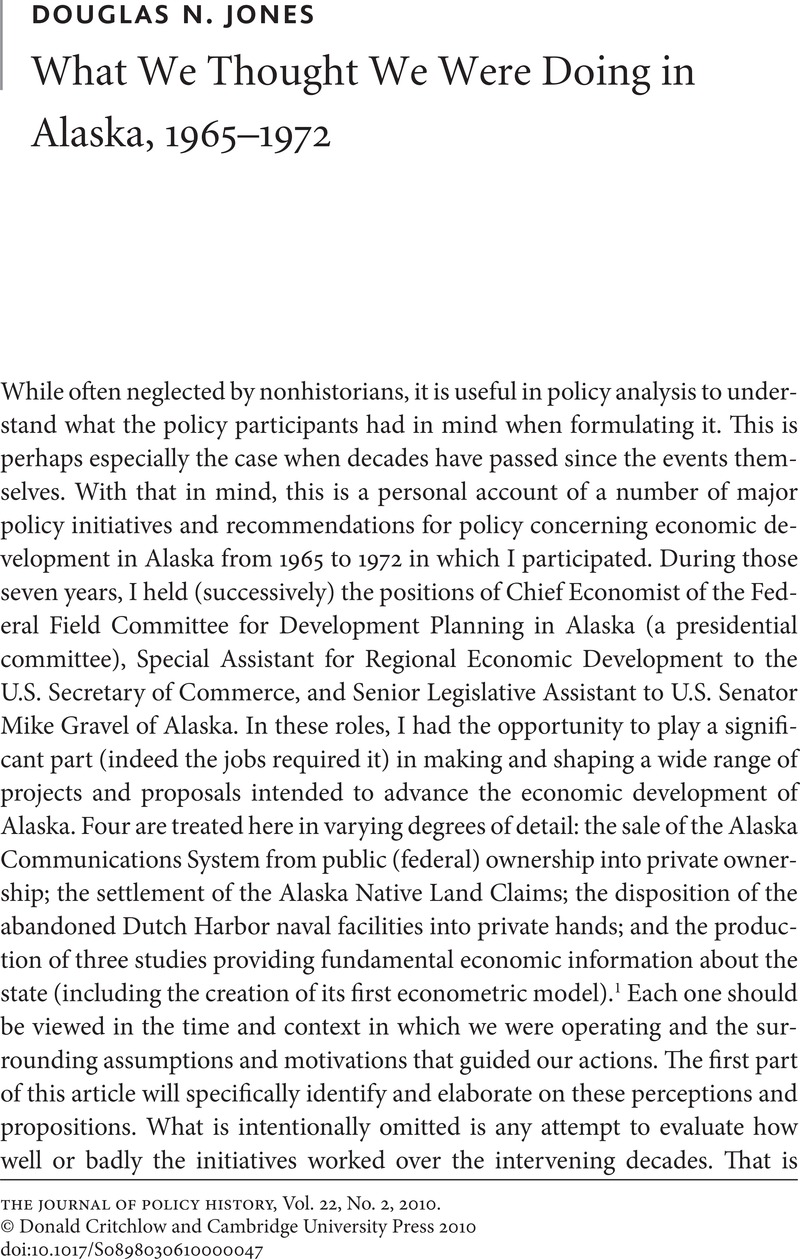Article contents
What We Thought We Were Doing in Alaska, 1965–1972
Published online by Cambridge University Press: 31 March 2010
Abstract

- Type
- Policy Retrospective
- Information
- Copyright
- Copyright © Donald Critchlow and Cambridge University Press 2010
References
NOTES
1. The reader may wonder why I omitted in my recitation of policy issues of the period the major public debate on the authorizing and routing of the Alaska oil pipeline for transporting North Slope oil to refineries in the continental United States. The answer is that this issue involved so many parties, was so salient at the highest levels of government, and dragged on for so long that ascribing individuals roles for virtually any one in its resolution would be overclaiming. Still, when the issue appeared endlessly stalled by litigation, and successive environmental impact statements were found faulty or incomplete by one powerful constituency or another, a frustrated Congress finally rose up and “declared” the requirements of the environmental statutes to have been satisfied and moved on with the authorization in November 1973. The Gravel office was a strong advocate of this strategy.
2. Executive Order No. 11150, April 1964, by the federal government and Executive Order No. 27 by the State of Alaska, 3 April 1964.
3. Presidential Executive Order No. 11182, 6 October 1964.
4. This discussion draws in part from our Report to the President, Economic Development in Alaska prepared by the Federal Field Committee for Development Planning in Alaska, August 1966.
5. For a full story of ACS disposal, see “Privatization of State-Owned Enterprises: The United States Has Done It Too,” in Critical Issues in Cross-National Public Administration, ed. Nagel, Stuart (Westport, Conn., 2000), chap. 5Google Scholar.
6. Also, the potential bidders would have preferred the simplicity and familiarity of straight bidding on price.
7. Public Law 90-135, 90th Cong., 1st sess., 14 November 1967.
8. Rather ironically, AT&T declined to be among the bidders in 1968, but then bought the system for a reported $365 million in 1995. The ostensible reason given to me for originally abstaining was the fear of antitrust action.
9. Many articles have been written about Native claims. An early one is Stuart French, “Alaska Native Claims Settlement Act,” the Arctic Institute of North America, Washington, D.C., August 1972.
10. Alaska Natives and the Land, prepared by the Federal Field Committee for Development Planning in Alaska, October 1968.
11. Introduced in the Congressional Record by Senator Henry Jackson, 18 February 1969.
12. We commissioned a study by Professor Bradford H. Tuck, “An Aggregate Income Model of a Semi-Autonomous Alaskan Economy” for the FFC, 1967.
13. Arlon R. Tussing et al., “Alaska-Japan Economic Relations: A Study of the Potential Contribution of Trade with Japan to Alaska’s Economic Development,” Institute of Social, Economic, and Government Research (ISEGR), University of Alaska, 1968.
14. For a relevant discussion, see Federal Regulation of Transportation in Alaska: FMC, ICC, CAB prepared for the FFC by Morris Chertkov, August 1967.
15. Perhaps we had some effect on the practice in that the Alaska legislature in 1971 abolished its Industrial Incentive Act, which had provided for preferential tax treatment of businesses. For a treatment of some of the issues, see Jones, Douglas N., “Property Taxation, Land Use, and Environmental Policy: The Alaska Case,” in Property Taxation, Land Use, and Public Policy, ed. Lynn, Arthur D. Jr., Symposium Proceedings of the Taxation, Resources, and Economic Development Committee, Publication #8 (Madison, 1976).Google Scholar
- 1
- Cited by




